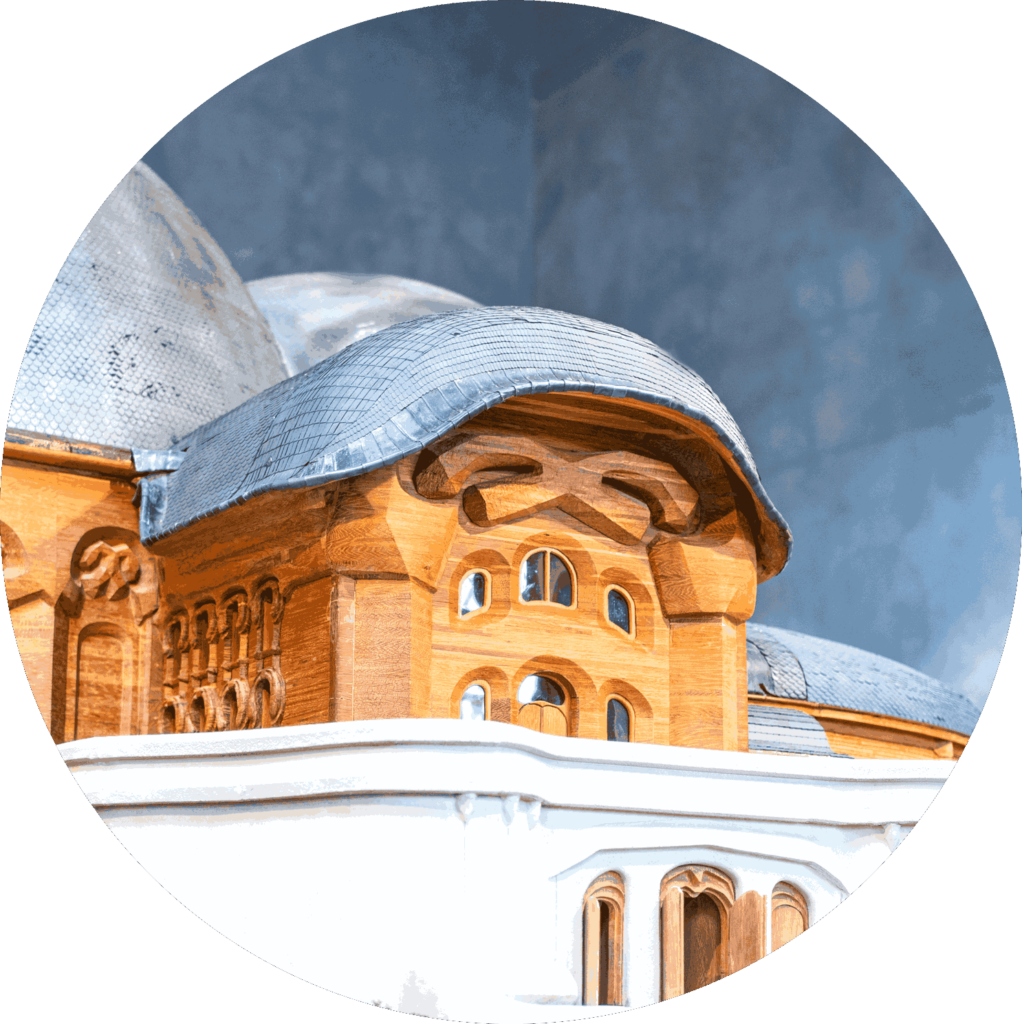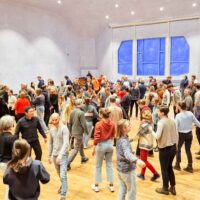Having been asked what kind of vision Rudolf Steiner developed in 1923 for the Anthroposophical Society after the Goetheanum burned down and on the way to the Christmas Conference – an Anthroposophical Society fit for the future, which makes possible, deserves and needs a second Goetheanum – I will briefly report on what was important, indeed essential, to him in doing so.
Friedrich Wilhelm Schelling wrote in his 1811 work ‹The Ages of the World›: «The past is known, the present is comprehended, the future is anticipated. That which is known is told, that which is comprehended is depicted, that which is anticipated is prophesied.»1
We therefore have the task of «knowing» and «telling» the past, of practising «spirit recollection» and talking about it. Furthermore, we have the obligation to «comprehend» and «depict» the present, i.e. to spiritually contemplate the current situation and its challenges – and to highlight it and our behaviour. After all, we are facing an open future which, however, should not be a tabula rasa but which we must at least «sense», anticipating in outline; otherwise we will be completely surprised, if not ambushed by it. We should live towards it in an awake state, learn to «prophesy» it – «practice spirit vision», including the coming spirit, the spirit (or demon) of what is to come.
But we are still – at the very least also – preoccupied with the past and partly burdened by it. Why? «How few know the actual past», writes Schelling.2 He does not write «actually know», but «know the actual». His statement is complex. It not only implies that we have far too little knowledge and awareness of history. Schelling was far ahead of most of us, not only with regard to the «ages of the world». However, he is concerned with still more and other things. He is concerned with the abolition of the past as the «actual» past – through the human tendency to cling to it and to miss out on the present and future as a result, indeed making it impossible. «Those who always wish for the past to return, who do not want to move on while everything is moving forward, prove through impotent praise of times past as well as through powerless scolding of the present that they are unable to have any effect in the latter.»3
Lastly, Schelling describes a second aberration or lapse in dealing with the historical: «The human being who is incapable of confronting their past has none, or rather they never get out of it, they live constantly in it.»4 Here lies the problem of the unredeemed, still abandoned past; because we have not mastered it and its challenges, we continue to live in its spell, to perpetuate it, without another present, indeed a ‹present› at all becoming possible, possible with presence of mind. We are surrounded by examples of this problem – a self-perpetuating past that is not a past – in the realm of politics and society; but also in the field of psychotherapy and traumatology. Schelling’s statement has long been common knowledge: «The person who is incapable of confronting their past has none, or rather they never emerge from it, they live constantly in it.» I will now leave Schelling.
Having been asked what kind of vision Rudolf Steiner developed in 1923 for the Anthroposophical Society after the Goetheanum burned down and on the way to the Christmas Conference – an Anthroposophical Society fit for the future, which makes possible, deserves and needs a second Goetheanum – I will briefly report on what was important, indeed essential, to him in doing so. We should «know» and «tell» about it in detail – in the sense of Schelling – but I want to keep it short here, so I will pick out seven points. Keeping these seven points or problems in mind, we are not in danger, I think, of falling into the first temptation, that of «praising» times past; rather, we find ourselves confronted with the second situation, that of the unresolved past, which to a large extent continues into the present. And this prevents real presence, presence of mind, from arising as a prerequisite for an actual future. Put positively: in the course of a general meeting and in the affairs of the Anthroposophical Society in general, it is necessary to «counter» this past criticised by Steiner, indeed to act in a completely different diction.

1. Representation
The first point: the representation of anthroposophy in public. Rudolf Steiner made it clear in 1923: the building was destructible because no Anthroposophical Society effectively protected it – and the «cause of Anthroposophy». Because the distortions and defamations of the daily press and various brochures and monographs had remained unanswered and a destructive mood had gained the upper hand. Because the members preferred to concern themselves with the «cycles» or their internal conflicts, personal desires, and ambitions, instead of looking after the public image of anthroposophy and countering the distortions with the true image of anthroposophy. «For in a certain sense the Dornach building, which spoke out aloud to the whole world, lacked the background of the protective Anthroposophical Society.»5 Rudolf Steiner certainly regarded the Anthroposophical Society as a public «body», a public society, a society with an «objective spirit», as «objective» as that of other specialist societies. It was intended to represent anthroposophy knowledgeably in the world, as a «world society» – just as the Society for Internal Medicine represents internal medicine, its expertise, scope, and dignity. This was not the case in 1923 in and through the Anthroposophical Society – a largely self-absorbed, conflict-ridden, publicly invisible or, according to Steiner, «sectarian» Anthroposophical Society. Can we really say that this is the «actual past» or do we still «constantly» live in it?

2. Interest and Shared Responsibility
The second point: Steiner wanted and needed – not for himself, but for the «cause of anthroposophy» to flourish in the world – an Anthroposophical Society that would take shared responsibility for the anthroposophical institutions in the world, be existentially interested in them, and committed to them, take their destiny upon itself and not stand on the sidelines as a mere study society. «The Society must grow along with anthroposophy.»6 Conversely, Steiner demanded of the teachers of the Waldorf School and all the other initiators of the anthroposophical establishments that they continue to commit themselves to the Anthroposophical Society from which they had all started. He considered the distance between the Society and the anthroposophical institutions, which had been developing since 1919, to be dangerous and momentous. The Society lost more and more contact with operative anthroposophy in the world – and the activists of the establishments left behind (and abandoned) that community of destiny to which they had once pledged themselves. The institutions will, Rudolf Steiner «prophesied», lose more and more of their spiritual substance and spiritual identity if this course is continued – and the Anthroposophical Society will become smaller and more and more insignificant. Can we say that we have overcome this «past»?

3. Taking on Social Tasks
Very closely connected with this – it actually all belongs together – is my third point: Rudolf Steiner wanted the Anthroposophical Society as such, as a society, to take on tasks in civilisation, tasks for which people ‹outside› can have respect. Only then, he said, would the Society become «reality» – through positive formation of will, through concrete content and commitment, «so that it stands as such in the world and the world finally knows what the Anthroposophical Society as such wants».7 Steiner was not speaking here of «occult» tasks that members – then as now – ascribe to themselves, but of those that are seen and recognised in the public sphere: «[…] that even the opponents say that there is something there for which they have respect, which is being worked on in the Anthroposophical Society.»8 Rudolf Steiner wanted such publicly relevant tasks to be spoken of in the meetings – including the general meetings – to be considered and mutually agreed upon.
I do not want to specifically raise the question here and in the following points as to whether we have mastered this problem or this task in 2023 – although I am very much of the opinion that intensive work has been done on this over the last hundred years. We are not living in 1923. And yet we are not rid of the past in Schelling’s sense, on the contrary.

4. World Awareness
He, Rudolf Steiner, fourthly wanted «world awareness» instead of a sectarian consciousness. He demanded of the members that they should make the problems of the time their own, instead of losing sight of the world of their time and activities in history over the multitude of their own problems. «A Society that places a Goetheanum in the world must itself look like a Goetheanum, at least in a certain way. But compare what the Goetheanum was and what the Anthroposophical Society is […].»9 The members should not «cocoon themselves in a sect», but lead a life in the world with «open eyes, with a practical sense». In reality, the Anthroposophical Society was damaging the reputation of anthroposophy and was actually becoming an «obstacle» to its further development. «Then anthroposophy must be completely misunderstood by the world because of the detours through the Anthroposophical Society.»10 All this also became an obstacle for young people who sought anthroposophy but could not «breathe» in such a society.

5. Knowledge and Respect
The last three points: Rudolf Steiner wanted the members of the Society to know about the scientific work and publications that had been done in their own ranks and were counted by Steiner as belonging to the realm of the School. He demanded respect for internal achievements – how could you demand that the ‹outside world› recognise anthroposophy if you yourself were incapable of similar attention and selflessness? It was a matter of «recognising human achievements and selflessly supporting making them known to the best of one’s ability, instead of simply «accepting» good publications «with tremendous apathy, as if it was all hugely a matter of course».11 If the Anthroposophical Society continued in this way, Steiner said in 1923, no anthroposophical book would be sold anymore in five years’ time. It was the task of the Anthroposophical Society to bring the results of anthroposophical work into the world – «in all things it is a matter of placing them before the whole world»12, the results had to be made effective in the world ‹through› the Anthroposophical Society. But for that, you first have to have a fundamental knowledge of the works, you have to be interested in them. The Anthroposophical Society is not a family or a social end in itself, but a serviceable tool or organ in the work of Michael.

6. Sense of Community
And this is my penultimate point, in international cooperation and community. The year 1923 was the one in which Rudolf Steiner initiated the founding of «autonomous national societies» in many countries of the world; they were to combine at the end of 1923 to form an international or ‹general› Anthroposophical Society. It was for such a world society in the spirit of Michael and with the above-mentioned tasks that Steiner wanted to construct a second building – and for no other.13 All «special interests» of groups were to be overcome; every new member should be able to feel that they are representing a «great cause» throughout the world by becoming a member of the Society. The Goetheanum had to contribute to «creating anthroposophical understanding throughout the world»14 – so that something effective could happen for the future of humanity and the earth. Results of the School of Spiritual Science in the various fields of civilisation must be worked on and brought into the world – with the help of the cosmopolitan Anthroposophical Society.

7. Relationship with the Being of Anthroposophy
And this – and this brings me to the last point – in responsibility before and for the being of anthroposophy. Rudolf Steiner repeatedly emphasised in 1923 that anthroposophy should be regarded «like a living being», «which walks invisibly among us», towards which we had to feel responsible. Anthroposophy as a «living entity» could be consulted at every moment of life – and it should be. This belonged to the conditions of life of the Anthroposophical Society: to see anthroposophy as a living being and to follow it, to feel it pulsating in our own heart – «like something knocking at the gate of our heart with anthroposophy and saying: let me in, for I am you yourself; I am the true being of your humanity!»15 In our own heart and in the heart of our fellow anthroposophist, in the I and in the Thou, in the social space of an Anthroposophical Society that had to find itself anew spiritually and socially in order to do justice to its mission.
Rudolf Steiner wanted «sincerity in love» in the Anthroposophical Society, instead of a culture of criticism and paralysis; he wanted purposeful work in the world and built on corresponding developments, which, however, did not really happen in 1923, despite countless meetings. «Stubbornness» and «fanaticism», «abstract idealism», «mysticism» and «special interests» continued to determine the being of the Society, Steiner said, even though people subjectively felt they were doing the best they could. The fundamental questions raised by Rudolf Steiner – such as the image of anthroposophy in the public sphere, the connection between the Society and the ‹movement›, ‹world awareness› and public tasks – were hardly addressed, as the study of historical documents shows; instead there were overly complicated social processes, votes and wishes of all kinds, with a predominantly subjective character. Steiner’s hope for a «forward-looking» Anthroposophical Society with a cosmopolitan orientation, with worldwide participation in the progress of anthroposophy and «the mission of Michael», was not fulfilled.
Needless to say, Rudolf Steiner in no way criticised the study work of the Society and its branches, which continued to take place and which he highly respected, indeed considered indispensable; but through this alone neither the Goetheanum nor the Michaelic age could be saved. At the end of 1923, Rudolf Steiner finally took over as chair of the Anthroposophical Society himself in order to show what he meant, how he meant it, and that what was meant – with regard to the Society and the School – was possible.
It is important to commemorate the Christmas Conference comprehensively in 2023, but also the processes that preceded it.16 Without solving the problems described by Rudolf Steiner and addressing the challenges and responsibilities associated with them, there will be no present and future in the meaning of Schelling. If, however, the gradual accomplishment of the determined tasks succeeds, in the meaning of the ‹Leading Thoughts›, the future is at least open and with it a goal, oriented towards the «ever-returning shore of the sun» (Ingeborg Bachmann).17
Translation Christian von Arnim
Title image West Staircase at the Goetheanum. Photo: Xue Li
Footnotes
- Friedrich Wilhelm Joseph Schelling: Die Weltalter. In: Ausgewählte Schriften. Vol. 4. Frankfurt a. M. 1985, p. 215.
- Ibid., p. 223.
- Ibid.
- Ibid.
- GA 259, p. 208.
- Ibid., p. 117.
- Ibid., p. 495.
- Ibid., p. 344.
- Ibid., p. 493.
- GA 257, p. 258.
- GA 259, p. 498.
- Ibid., p. 356.
- Cf. Peter Selg, Die anthroposophische Weltgesellschaft und ihre Hochschule. Dornach 2023.
- GA 259, p. 607.
- Ibid., p. 681.
- Cf. i.a. Sergei O. Prokofieff, May Human Beings Hear It. The Mystery of the Christmas Conference. Forest Row 2014; Sergej O. Prokofieff/Peter Selg, Die Weihnachtstagung und die Begründung der neuen Mysterien. Arlesheim.
- Cf. Peter Selg, Die anthroposophische Weltgesellschaft und ihre Hochschule. Dornach 2023.






It seems to me that each of these hopes for the Anthroposophical Society rest on the foundation of self-knowledge through mediation and spiritual awakening. It appears to me, from my limited vantage point in the United States, that we are still overly concerned with Anthroposophy as a system of knowledge. I hope that now, 100 years after the founding of the Society and as we approach the 100th anniversary of Rudolf Steiner’s death, that we can refocus the Society on self-development rather than knowledge. We need, I believe, to develop a growth mind-set so that we can meet the challenges of the future.
The leadership needs to specifically step up and take on the racism charges in Steiner’s quotes. Members believe he was advocating racism. Ask Tess Parker and the diversity action group in the U.S. Stop ignoring.
Jean Yeager
To believe, as a “member”, that Dr. Steiner ever advocated racism is to reveal oneself “not” a member.